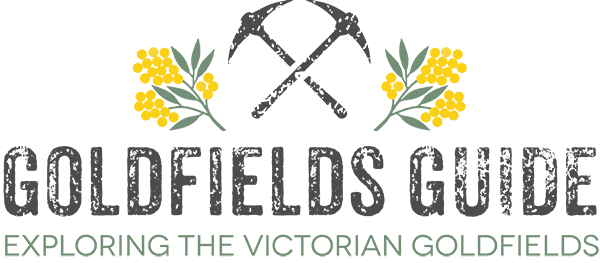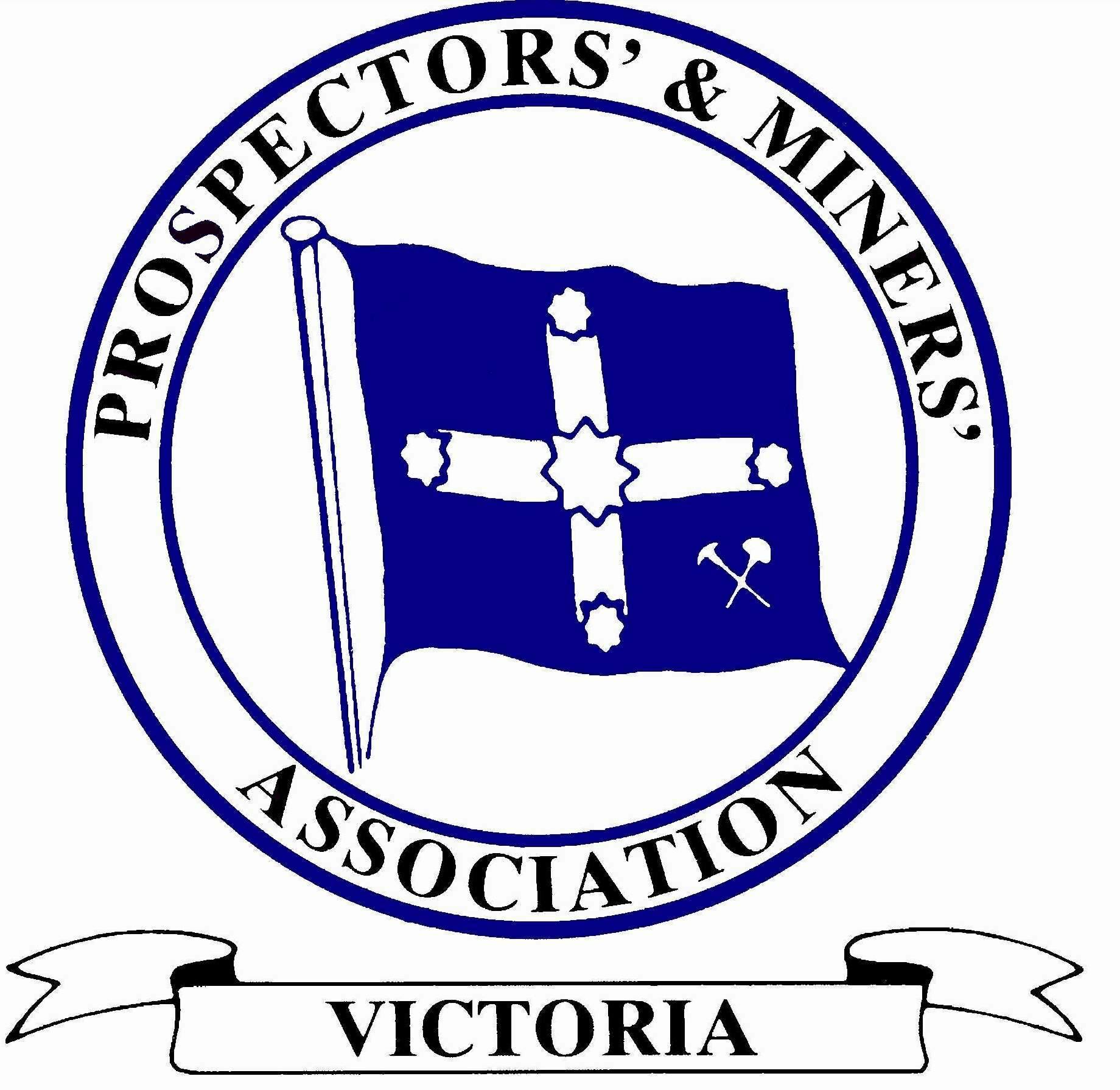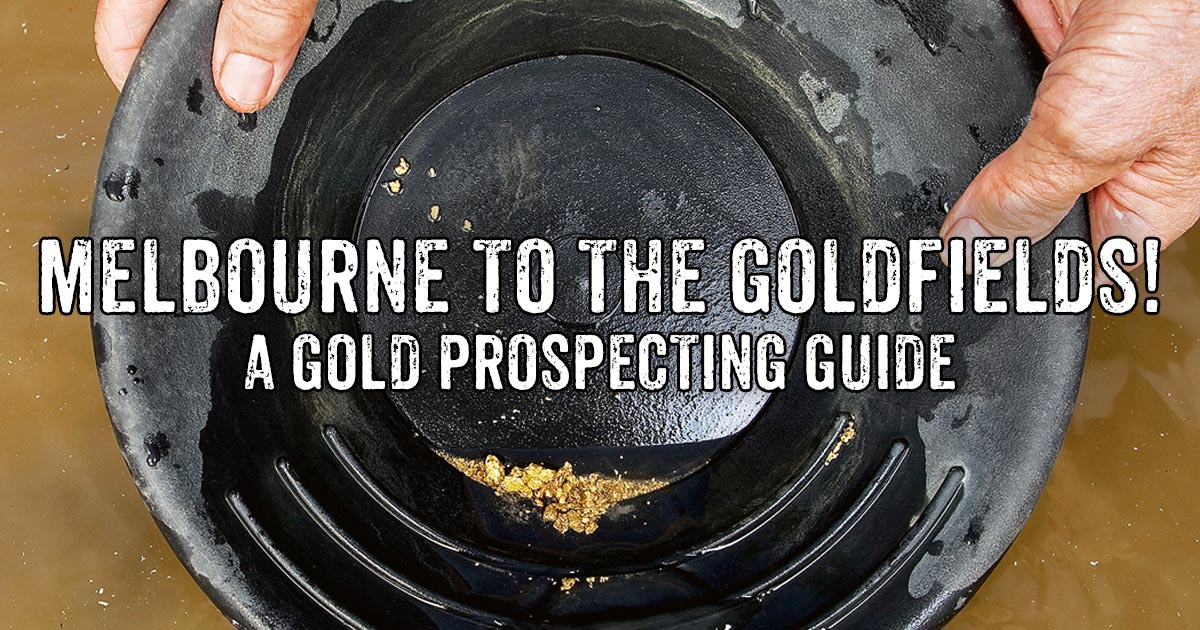
Thinking of heading out from Melbourne to try your luck searching for gold in the Victorian Goldfields? We've got all the information you need to get started!
By heading out from Melbourne to go prospecting, you're continuing on with a significant part of Victoria's heritage.
This very trek has roots stretching back to 1851, when thousands upon thousands of optimistic men and women headed from Melbourne to the goldfields of Victoria in hopes of striking it rich.
At the onset of the Victorian gold rush, the entire state was turned upside down with gold fever!
People came to Melbourne from all over the world to head out the diggings, and locals were abandoning their lives and jobs in town to go and try their luck with a gold pan.
During the early days of the gold rush, rich new goldfields were being discovered all the time.
The roads between Melbourne and areas like Ballarat, Bendigo, Mount Alexander, McIvor, Mount Korong, and Ovens were filled with travelers who had the very same idea that you have now - to head out to the bush and find some gold!
Significant gold discoveries continue to be made in the Victorian Goldfields to this day, with exciting new finds regularly hitting the news. So what are you waiting for? Let's get started!
Where to find gold in the Victorian Goldfields
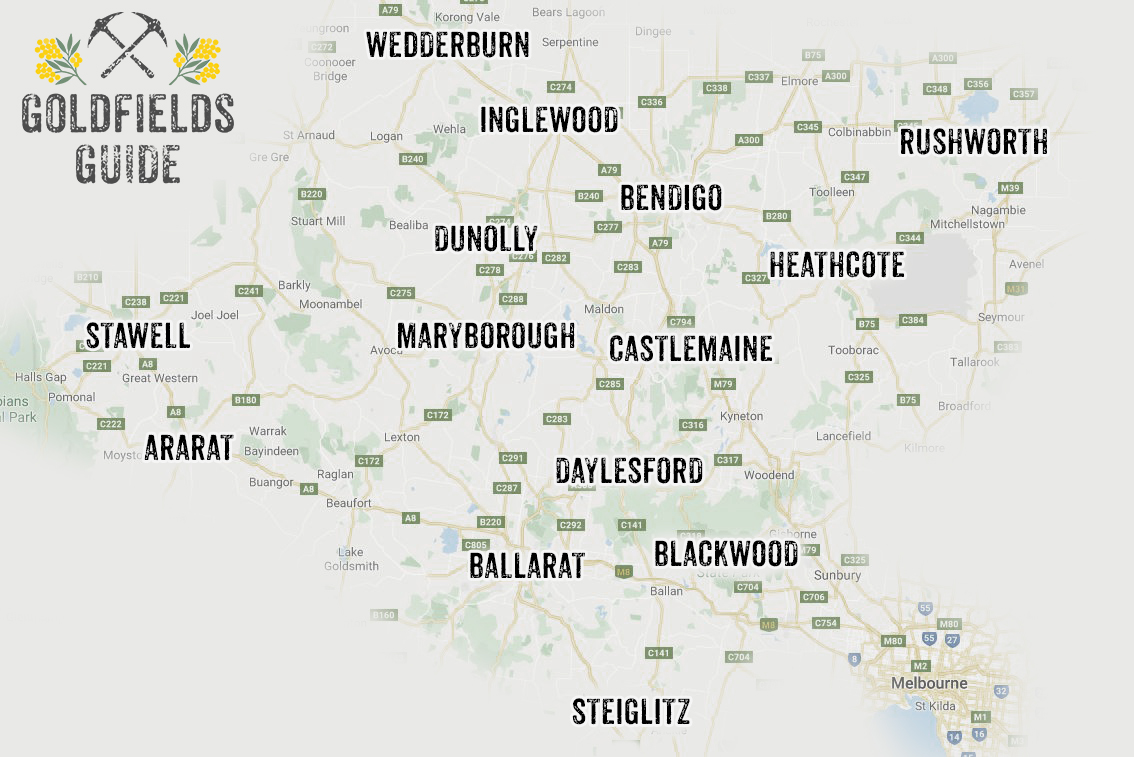
Some of the closest goldfields areas to Melbourne are Steiglitz, Blackwood, Ballarat, Daylesford, Castlemaine, Bendigo and Heathcote.
These are great places to get started, or you could head further afield to Maryborough, Dunolly, Inglewood or Rushworth, or a bit further still to reach Ararat, Stawell and Wedderburn.
To give you an idea of where to start, here are the travel distances from Melbourne (CBD) to various goldfields.
These are in order by distance, with the closest goldfields to Melbourne coming first.
- Blackwood: 1 hr 11 min
- Steiglitz: 1 hr 17 min
- Ballarat: 1 hr 26 min
- Daylesford: 1 hr 27 min
- Castlemaine: 1 hr 27 min
- Heathcote: 1 hr 32 min
- Bendigo: 1 hr 47 min
- Rushworth: 2 hr
- Maryborough: 2 hr 1 min
- Dunolly: 2 hr 2 min
- Inglewood: 2 hr 2 min
- Ararat: 2 hr 17 min
- Wedderburn: 2 hr 21 min
- Stawell: 2 hr 42 min
Any of these areas can definitely be done as a day trip with an early start, but the driving time does cut into your day out prospecting.
An overnight, weekend (or weeklong!) camp is a great option.
Places to camp while gold prospecting in the Victorian Goldfields
Looking to extend your prospecting trip into camping trip? No worries!
Free camping is allowed throughout most State Forests, and there are plenty of campgrounds located in great prospecting areas.
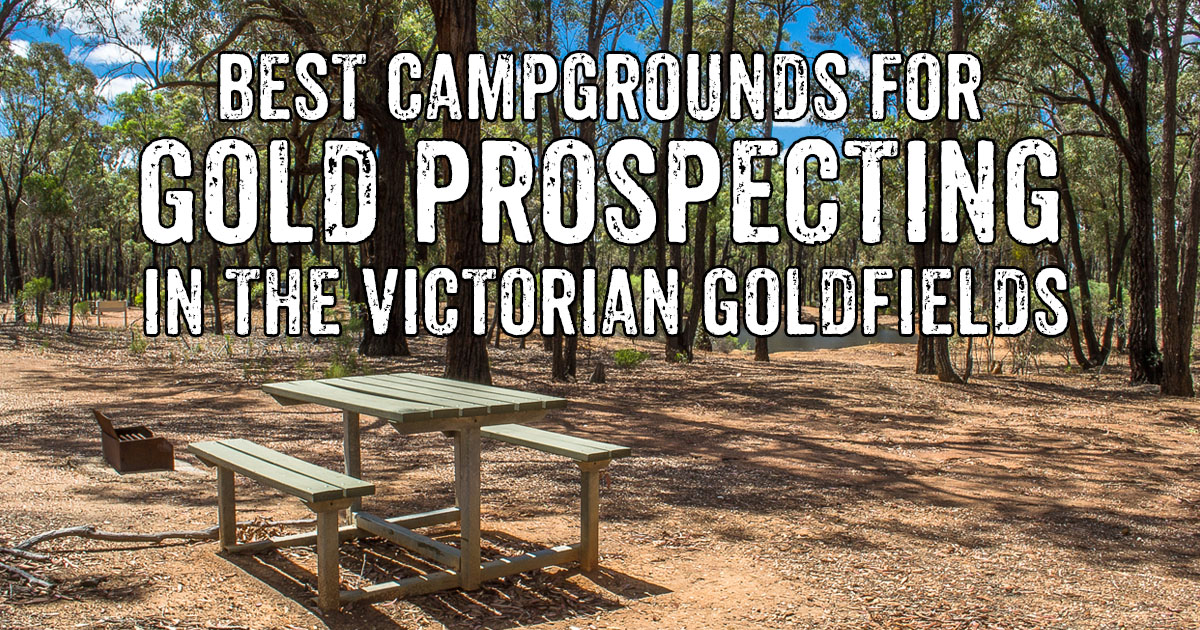
Check out our list of campgrounds which are perfect for gold prospecting trips across the Victorian Goldfields.
ONLINE GOLD PROSPECTING GUIDES
Off to the diggings, then and now
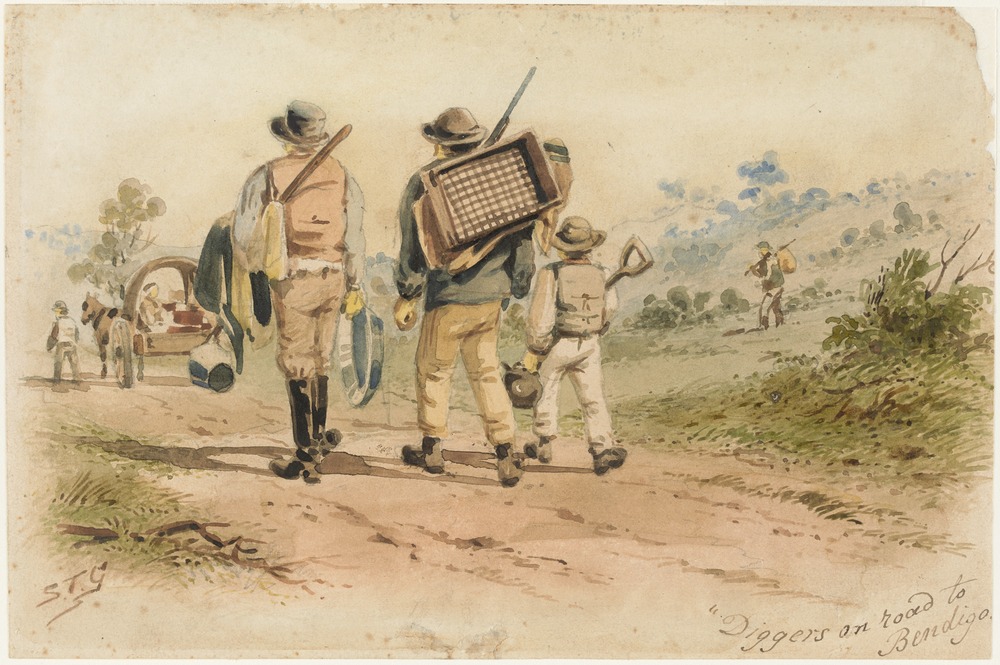
Diggers on the road to Bendigo, S.T. Gill. Image source: Old Treasury Building.
During the 19th century gold rush, the trek from Melbourne to the goldfields of Victoria had some very interesting features along the way!
- Sly grog shops. Alcohol was prohibited on the goldfields for a few years, which resulted in the appearance of "sly grog shops" which could be found throughout the goldfields and along the roads to the diggings. These were often run beneath the guise of a Coffee Tent, and were sometimes burned down on the spot upon discovery by the authorities! Today you'll be able to nick past the bottle shop and grab whatever alcohol you may require for your trip to the goldfields.
- The Black Forest! The road from Melbourne to the famed Mt Alexander and Bendigo diggings took travelers through the treacherous Black Forest. Notorious for its terrible roads and the threat of assault and robbery by bushrangers, the Black Forest gained a fearsome reputation. The beauty of the Mt Macedon area was accompanied with the apprehension travelers felt as they neared the dreaded woods. Today when passing through the area to head for Castlemaine and Bendigo, you'll certainly still notice the beautiful scenery.
- Bushrangers. As we just mentioned, bushrangers were a terrible threat to 19th century gold diggers! They preyed on gold convoys which were transporting gold to Melbourne from the goldfields, travelers to the goldfields who carried fresh supplies and funds, or on lucky diggers returning to Melbourne with pockets full of gold. You don't need to look out for bushrangers today, but do keep an eye out for kangaroos on the roads while driving! They'll pop up out of nowhere sometimes and jump out right in front of you.
- Message trees. Tree stumps or trunks along the roads to the diggings served as message boards, where travelers could leave notes for others who may be passing after them. While we don't have message trees anymore, we do have something much more efficient - social media! There are loads of great gold prospecting Facebook groups and online forums where prospectors can connect with each other and share information.
- Bogged drays. People travelling by horse and dray to the goldfields ran the risk of getting stuck in the mud! Particularly bad spots in the road often had an opportunistic fellow waiting by with his bullocks, ready to help pull out a stuck dray - at a cost, of course! Today you're unlikely to be travelling by dray, but if you're out the bush in the winter you do run the risk of getting bogged. If you're in a two wheel drive vehicle, there are some great prospecting areas to reach which don't require any tricky maneuvering through the bush (Waanyarra Recreation Site near Dunolly, Slaty Creek near Creswick, Butts Reserve in Maldon, and Tarnagulla Recreation Reserve, just to name a few).
Many aspects of the trip from Melbourne to the Goldfields may have changed over the last 170 years, but one thing is absolutely certain - Victoria has never quite shaken that gold fever!
Things to watch out for while prospecting in the Victorian Goldfields
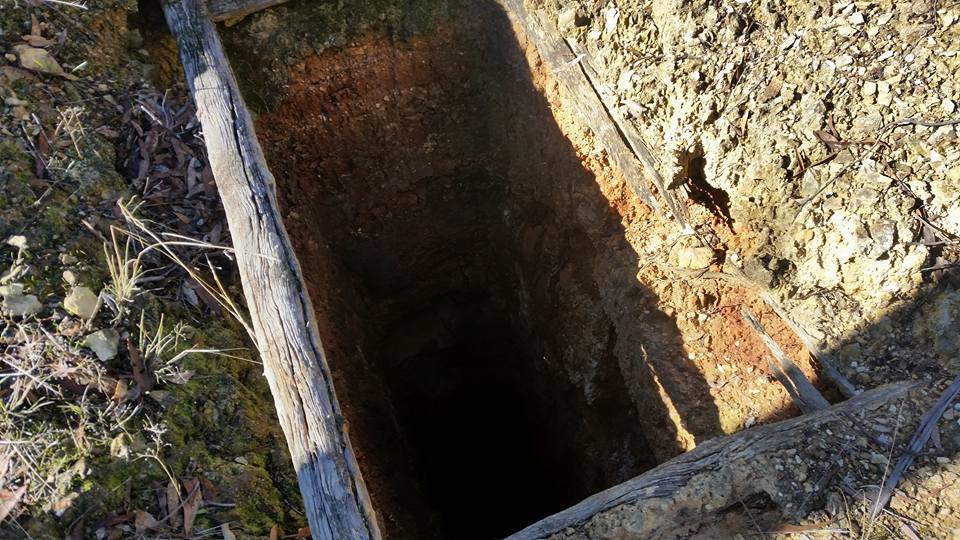
The main things you'll need to watch out for while prospecting in the Victorian Goldfields are open mine shafts, snakes during the warmer months, and kangaroos while driving.
We've got a great page which talks about the dangers of mine shafts in the Victorian Goldfields, and if you're detecting during summer then you may want to invest in a pair of gaiters to protect your ankles / lower legs.
First time heading out prospecting?
The first thing you'll need - a Miner's Right
Before you go gold prospecting, the first thing you're going to need is a Miner's Right - this is a licence which gives you the right to search for gold in Victoria.
A miner's right only costs about $28, lasts for 10 years, and is super easy to buy online. Click here to purchase a miners right from Earth Resources.
While you're on the Earth Resources website, take a look at their information on what land types you are allowed to prospect on.
The second thing you'll need - prospecting equipment
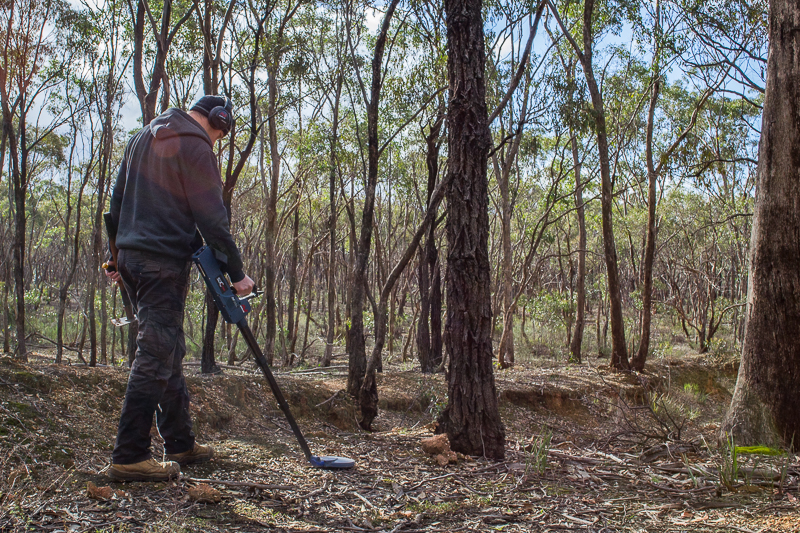
Whether you are planning to go detecting, panning or sluicing, you'll need to have the right tools.
You may already have your own gold detector, pan or sluice, but if you don't - no problem! There are plenty of fantastic gold shops throughout the Victorian Goldfields where you can hire prospecting equipment, or have a chat about making your first equipment purchase.
Staff in gold shops are extremely knowledgeable and helpful when it comes to getting people started with gold prospecting - many even offer prospecting workshops.
Take a look at our directory of gold shops, prospecting tours, and detector hire in the Victorian Goldfields.
A gold pan is the cheapest equipment to get started with, only costing about $20.
Next up are sluices and highbankers for a few hundred dollars, then gold detectors which can cost anywhere from around $1,000 (for a Minelab Gold Monster 1000) to over $10,000 (for a Minelab GPZ 7000).
You will also come across cheaper metal detectors or relic hunting machines, but these are typically designed for finding coins and relics and are not so good for gold prospecting.
Hiring a gold detector from a gold shop is an excellent way to start out.
The third thing you'll need - the know-how
If you are looking for information on how to use your prospecting equipment, there are so many helpful videos on YouTube.
We have gathered a huge directory of gold prospecting YouTube Channels which share loads of information on gold prospecting methods, prospecting equipment, gold discoveries, and more, all based in the Victorian Goldfields.
Watching these YouTube videos also gives you a great idea of what sort of ground you should be looking for, what areas of creeks to focus on, etc, to increase your chances of finding gold.
They are also a great way to pass the time between detecting trips!
We've also got a fantastic collection of online resources for researching gold prospecting areas, so if you're looking to dig in and expand your knowledge then definitely go check those out as well.
While you're at it, check it out this massive collection of historical goldfields maps! These are all free to view online.
We've got loads of other fantastic resources for gold prospectors right here on Goldfields Guide. Click here to browse through them all.
Also of interest
- Guide to gold prospecting in the Victorian Goldfields
- Places to prospect in the Victorian Goldfields
- Interactive map showing lots of places to prospect in the Victorian Goldfields
- Gold-bearing creeks and rivers in Victoria
- Crevicing for gold in creeks and rivers
- Researching gold prospecting and history - online resources
- Surfacing in the Victorian Goldfields
- Gold shops, detector hire and gold tours in the Victorian Goldfields
- YouTube channels from the Victorian Goldfields
- Dangers of mine shafts in the Victorian Goldfields
- Online directory of Victorian gold maps
- Gold prospecting maps for Victoria's State and National Parks
- Historical gold maps of the Victorian Goldfields
- How to read historical gold maps
- Gold history locations on Goldfields Guide
PROSPECTORS AND MINERS ASSOCIATION VICTORIA
Established in 1980, the Prospectors and Miners Association of Victoria is a voluntary body created to protect the rights and opportunities of those who wish to prospect, fossick or mine in the State of Victoria, Australia.
You can support the PMAV in their fight to uphold these rights by becoming a member. You'll also gain access to exclusive publications, field days, prospecting tips, discounts and competitions.
Check out the PMAV website for more information.
